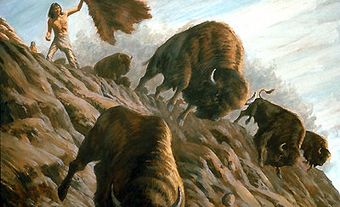The Mailhot-Curran Site is an ancient Iroquoian village located in the municipality of Saint-Anicet in southwestern Québec, about 70 km upstream from Montreal. The archaeological site is located deep in the backcountry, on a hill of glacial origin situated about 8 km from the St Lawrence River. Unlike other Iroquoian village sites, which are generally less than 150 m from a watercourse, the closest water point is found some 800 m to the north.
The Mailhot-Curran site was discovered nearly 20 years ago during an archaeological survey program conducted by archaeologist Michel Gagné on behalf of the MRC du Haut-Saint-Laurent and with the support of the Québec Ministry of Culture, Communications and the Status of Women. Subsequent excavations were conducted over a period of 3 years between 1999 and 2001.
The site, which dates from about 1500 AD (during the Late Woodland Period) based on the facture of the pottery recipients, is linked to the presence of the St Lawrence Iroquoians (see Aboriginial People: Eastern Woodlands), a group of sedentary farmers who most likely populated the St Lawrence Valley in the 13th century AD. Jacques Cartier met with its descendants during his travels on the St Lawrence River (1534-36) at Stadacona, the present city of Québec, and the village of Hochelaga on the island of Montreal. The St Lawrence Iroquoians are part of the Iroquoian linguistic and cultural family, composed of about 10 different nations which mostly occupied the American Northeast at this period, as well as southern Ontario and Québec.
These peoples share similar lifestyles and cultural traits. Among other things, they are all sedentary farmers and live year round in villages consisting of longhouses shared by several families of the same maternal clan. Other well-known pre-contact Iroquoian villages in the region of Saint-Anicet are the Droulers-Tsiionhiakwatha and McDonald sites.
Despite the fragmentary state of research, the Mailhot-Curran site revealed quite a diverse assemblage consisting of more than 23 000 objects including fragments of pottery vessels, pipes, beads, and clay wastes. There are also bone remains of mammals and fish, bone tools, mullers for grinding plants, and the remains of several crop species including corn, bean, and sunflower. So far, the site has yielded the remains of a very small longhouse measuring only 13 meters in length, whereas a typical longhouse of this period is usually 30-meters long. An important part of the archaeological deposit is well-preserved, and it is estimated that the space could have accommodated 3 or 4 longhouses and nearly 100 people.
The Mailhot-Curran site is significant mainly because it is associated to the pivotal period that marked the disappearance of the St Lawrence Iroquoians in the late 16th century. As the village was occupied shortly before the collapse of the population, the site could be crucial for understanding the events that unfolded in the St Lawrence at that time.
Indeed, when Samuel de Champlain travelled through the St Lawrence Valley in 1603, he noted that the territory was no more occupied by the Iroquoian groups that Jacques Cartier had encountered a few decades earlier. Even then, the inhabitants of Hochelaga had mentioned to Jacques Cartier the existence of conflicts between the Iroquoian groups living in the region upstream from Montreal. This suggests that relationships in that particular sector of the St Lawrence Valley were already deteriorating considerably during this period. These troubling events could have encouraged the communities living around Saint-Anicet to abandon the St Lawrence River area to take refuge further inland, where the site Mailhot-Curran was discovered.
In fact, except for a few bits of scattered information, very little is known concerning the events that surrounded the disappearance of the St Lawrence Iroquoians from the St Lawrence Valley during the second half of the 16th century. Since there are no written records, archaeologists have favoured three main models to explain this significant episode. These focus on the impact of the diseases transmitted by the Europeans, on the wars of conquest undertaken by outside groups, primarily the Iroquois of the League of the Five Nations, and on the control of trading routes with Europeans. Even today, the reasons for their disappearance still raise many questions among scholars.

 Share on Facebook
Share on Facebook Share on X
Share on X Share by Email
Share by Email Share on Google Classroom
Share on Google Classroom







